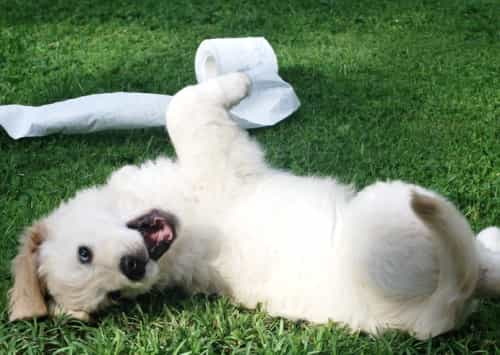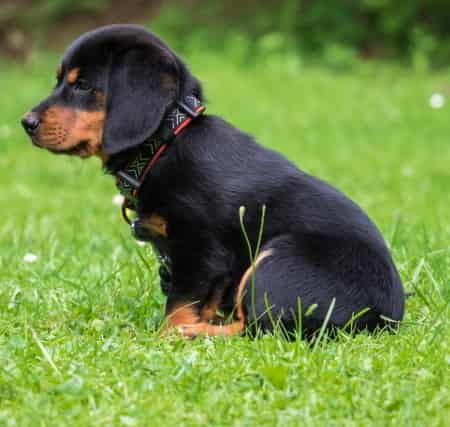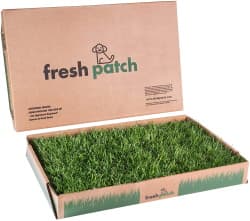Potty Training A Puppy Or Adult Dog
The Simple and Easy Way
Potty training a puppy or older dog isn't a complex thing, but it does require some knowledge, a bit of patience and
above all consistency. But it's a simple process.
On this page:
House training a puppy, done right, is probably the best thing you can do to start a lasting relationship with your dog pal.
 He's Trying!
He's Trying!Having said that, many new pet owners seem to get confused about the process. If you are confused, then your dog or puppy is going to be confused also.
Potty Training Confusion
A major area of confusion when it comes to potty training a puppy dog is how long it will take. Friends may tell you of their experience, but the learning curve for one dog won't necessarily be the same for another.
Factors such as type of dog breed, puppy or adult, training a rescued dog or one from a puppy mill, etc., will affect the learning curve in some cases.
So, don't blame the dog if he isn't trained in a certain amount of time, he may be confused by the method
or just needs more time. It's far better to just keep up the routine without a "set" time frame in mind and
success will follow.

Which Method to Choose?
Another dilemma for some owners is which method to choose - paper-training, using a specifically designed indoor dog potty system, or outdoor training?
Eliminate confusion for "your dog" by picking one method and staying with until your pet is trained. This article discusses the outdoor option.
Some owners may have personal reasons for choosing an indoor method
or may need to include an indoor option as well if they are gone for long periods during the day.
Crate Training
The dog crate is your friend make no mistake, so be sure to have one available.
Some owners are unsure about the amount of time to leave
their dog in a crate, but this isn't hard if you take notes on the time between necessary eliminations. You'll have it figured out pretty fast.
Too long in a crate is just asking for trouble and can sabotage
potty training a puppy or dog. As I said, if you
observe the time between pees and poops, you'll know!
Bottom line, housebreaking a puppy or older dog is essential if you want
to have a companion you can live with and trust to leave in your home
without accidents. Since a pet can't train himself, just relax and follow the potty training process.
In fact it will happen quicker if your are relaxed because you won't pass along any negative vibes to your pup.
Potty Training A Puppy - The Basics
- It's a round-the-clock job for a while.
- Set up a feeding schedule so that his elimination can be more predictable.
- Don't leave food and water out all the time or you'll never know when your dog has to go.
- Buy a dog crate. Select one that can be adjusted as your dog grows.
- Be consistent, be consistent, be consistent. Sorry about that, but it's the most important point.
- Train in only one area of the house where you are close by - they like to be near you.
- Lock the doggie door if you have one - too confusing while training.
- Don't let your dog see you clean up any accidents. No, he won't think you're the maid, but he may think going in the house is OK!
- Don't play with your dog right after eating unless you want another kind of problem to clean up!!
A Potty Training Method You Can Use
The following tips are guidelines that you can apply to potty training a puppy or an older dog. Personally, I have had great success using this easy method with my dogs.
- Pick a place outside for your dog to go potty and take him to this same place every time to minimize confusion. To reinforce the training ritual, begin with a command such as "outside" as you walk or carry your dog toward the door. Upon reaching the potty spot, use a phrase such as "get busy" and keep repeating it until he eliminates. If no elimination occurs, try again in a short while.
- Be sure to give your dog abundant praise when he has a successful potty visit. If you add a small treat at this time it will give him an even stronger message that he has pleased you.
- Potty training a puppy requires a consistent schedule, so - at a minimum, take your dog out first thing in the morning, about 15-20 minutes after each meal, and before going to bed. Regardless of the minimum, if you can also pop him outside every hour, so much the better.
- When you are house training a dog, keep track of the time he usually goes potty after meals so that you can predict it more accurately.
- When you are potting training your puppy, be aware and make note of his behavior patterns when he needs to eliminate. Once you can spot these patterns, you can let him out and nip those accidents in the bud!
- Don't scold when he has an accident unless you catch him in the act. If you are quick enough, you might even be able to rush him outside to finish the job.
Let your dog get comfortable with napping in a crate with the door open. Use the crate,
door closed, for short periods of time when you can't watch your dog or if a recent potty trip outside was
unsuccessful. After a brief time inside the crate, your dog may now be more ready for a second trip outside.
- You can also use the crate overnight, but don't ever use the crate as punishment. And in regard to the overnight routine, plan to get up a couple of times for a quick visit outside.
Potty Training Summary
- Observe and learn his patterns while you are in the process of housebreaking your puppy, Many puppies will want to relieve themselves after playing, after a nap, or if they have been preoccupied chewing on a toy for some time.
- Give him ample opportunities for trips outside during the early days of potty training. That will mean getting up at night for a while. This is especially true when potty training a puppy.
- Remember, a young dog will not have complete control of his bladder until he is more mature. So don't be too hard on him, just keep repeating the process and he will catch on. Take heart, it's nothing compared to how long it took to train your kids!
Dogs really want to please us, they just need time to learn what's expected.
You are the most important part of the process - you are his leader. A few weeks or months devoted to potty training a puppy are well worth the effort when you consider the many years of companionship ahead of you.
And, think how proud you will be when he graduates from potty training school.
Before You Go...
If you like the content of this page, as well as others on my site, please give it some love by clicking on the heart in the lower right hand corner. This helps me keep providing enjoyable and useful content.
Thank you.
More Dog And Puppy Training Topics


